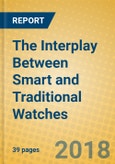The decline of traditional watches and the explosion of smartwatches ignited a cause-effect narrative. Yet, the recovery of traditional watches, and the slowdown of wearable electronics, clearly indicates the two categories tap into different consumer groups and can easily coexist. This report analyses the interdependencies of these categories, which increasingly influence each other, as a growing number of either traditional or smart players cross the line and further blend both references.
The publisher's The Interplay Between Smart and Traditional Watches global briefing offers detailed strategic analysis of the global Personal Accessories market by pinpointing growth sectors and identify factors driving change. The report identifies leading companies and brands within the keenly contested, fashion-driven competitive landscape, trend developments, economic/lifestyle influences, seasonal patterns, market and distribution strategies. Forecasts illustrate how the market is predicted to develop between mature and emerging countries, threats facing the business as well as opportunities to be seized for further growth.
Product coverage: Bags and Luggage, Jewellery, Watches, Writing Instruments.
Data coverage: market sizes (historic and forecasts), company shares, brand shares and distribution data.
Why buy this report?
The publisher's The Interplay Between Smart and Traditional Watches global briefing offers detailed strategic analysis of the global Personal Accessories market by pinpointing growth sectors and identify factors driving change. The report identifies leading companies and brands within the keenly contested, fashion-driven competitive landscape, trend developments, economic/lifestyle influences, seasonal patterns, market and distribution strategies. Forecasts illustrate how the market is predicted to develop between mature and emerging countries, threats facing the business as well as opportunities to be seized for further growth.
Product coverage: Bags and Luggage, Jewellery, Watches, Writing Instruments.
Data coverage: market sizes (historic and forecasts), company shares, brand shares and distribution data.
Why buy this report?
- Get a detailed picture of the Personal Accessories market;
- Pinpoint growth sectors and identify factors driving change;
- Understand the competitive environment, the market’s major players and leading brands;
- Use five-year forecasts to assess how the market is predicted to develop.
Table of Contents
The Interplay Between Smart and Traditional WatchesIntroduction
State of Play
Co-existing Rather Than Competing
Differentiation Strategies
Challenges and Opportunities
Appendix








